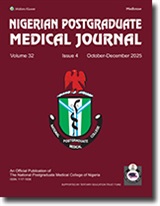IN A NUTSHELL Authors' NoteThis study examined the knowledge and utilisation of Malaria prevention strategies by pregnant women attending some selected primary health centres (PHCs) in Borno State, Nigeria. It concludes that, although pregnant women are aware of malaria prevention methods, there is a gap in their effective utilisation. To address this, targeted health education, intersectoral collaboration and supportive monitoring at PHC and community levels are recommended
PEAH is pleased to share an original article first published in Nigerian Postgraduate Medical Journal, 32(4):p 290-296, Oct–Dec 2025
Knowledge and Utilisation of Malaria Prevention Strategy among Pregnant Women in Some Selected Primary Health Centres in Maiduguri, Borno State, Nigeria
Quotation
Samuel, Gabriel; Abdullahi, Mohammed Ibn1; Danladi, Samuel Sam2; Jonah, Japhet Haruna3; Tweneboah, Emmanuel4; Musa, Ahmed5. Knowledge and Utilisation of Malaria Prevention Strategy among Pregnant Women in Some Selected Primary Health Centres in Maiduguri, Borno State, Nigeria. Nigerian Postgraduate Medical Journal 32(4):p 290-296, Oct–Dec 2025. | DOI: 10.4103/npmj.npmj_152_25
Full Text HERE
ABSTRACT
Background
Malaria remains a significant global health threat, with Africa bearing the highest burden. Pregnant women in Nigeria are particularly vulnerable due to the country’s high malaria prevalence.
Objectives
The study examined the knowledge and utilisation of Malaria prevention strategies by pregnant women attending some selected primary health centres (PHCs) in Borno State, Nigeria.
Subjects and Methods
The study was conducted using a cross-sectional descriptive survey in two local government areas: Maiduguri Metropolitan Council and Jere, in Maiduguri, Borno state, Nigeria. Furthermore, Fisher’s formula determined the sample size, and data were collected from 407 pregnant women using a questionnaire recruited through a multistage Sampling. Finally, IBM SPSS version 27 statistical software was used for data analysis.
Results
The mean age ± standard deviation of 26 ± 4.08, and most (80.8%) of pregnant women have good knowledge of malaria prevention. The utilisation of malaria prevention strategies was low, with 79.1% showing an overall poor usage. 60.9% reported using long-lasting insecticide-treated nets, 20.6% had never used larval source management. 54.8% of the respondents were in their second trimester. Knowledge of malaria prevention was associated with the trimester of pregnancy (P = 0.0044), gravidity (P = 0.019) and education (P = 0.001). However, no relationship was found between maternal religion and knowledge of malaria prevention (P = 1.000).
Conclusions
Although pregnant women are aware of malaria prevention methods, there is a gap in their effective utilisation. To address this, targeted health education, intersectoral collaboration and supportive monitoring at PHC and community levels are recommended
